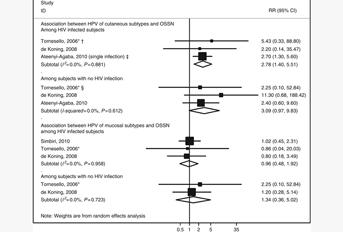Associação Portuguesa de Investigação em Cancro
HIV and HPV infections and ocular surface squamous neoplasia: systematic review
HIV and HPV infections and ocular surface squamous neoplasia: systematic review

H Carreira 1,2, F Coutinho 1,3, C Carrilho 4,5 and N Lunet 1,2
1. Institute of Public Health of the University of Porto, Porto, Portugal
2. Department of Clinical Epidemiology, Predictive Medicine and Public Health of the University of Porto Medical School, Porto, Portugal 3. Department of Oncology, Centro Hospitalar do Porto, Porto, Portugal
4. Department of Pathology, Medical Faculty, Eduardo Mondlane University, Maputo, Mozambique 5. Department of Anatomical Pathology, Maputo Central Hospital, Maputo, Mozambique
Abstract:
background: The frequency of ocular surface squamous neoplasias (OSSNs) has been increasing in populations with a high prevalence of infection with human immunodeficiency virus/acquired immunodeficiency syndrome (HIV/AIDS) and infection with human papillomavirus (HPV). We aimed to quantify the associationn between HIV/AIDS and HPV infection and OSSN, through systematic review and meta-analysis.
Methods: The articles providing data on the association between HIV/AIDS and/or HPV infection and OSSN were identified in MEDLINE, SCOPUS and EMBASE searched up to May 2013, and through backward citation tracking. The DerSimonian and Laird method was used to compute summary relative risk (RR) estimates and 95% confidence intervals (95% CI). Heterogeneity was quantified with the I2 statistic.
Results: HIV/AIDS was strongly associated with an increased risk of OSSN (summary RR=8.06, 95% CI: 5.29–12.30, I2=56.0%, 12 studies). The summary RR estimate for the infection with mucosal HPV subtypes was 3.13 (95% CI: 1.72–5.71, I2=45.6%, 16 studies). Four studies addressed the association between both cutaneous and mucosal HPV subtypes and OSSN; the summary RR estimates were 3.52 (95% CI: 1.23–10.08, I2=21.8%) and 1.08 (95% CI: 0.57–2.05, I2=0.0%), respectively.
Conclusion: Human immunodeficiency virus infection increases the risk of OSSN by nearly eight-fold. Regarding HPV infection, only the cutaneous subtypes seem to be a risk factor.
British Journal of Cancer advance online publication 12 September 2013; doi: 10.1038/bjc.2013.539
http://www.nature.com/bjc/journal/vaop/ncurrent/abs/bjc2013539a.html






